Digital Technology Transformation in E-commerce: A Study on Asos
VerifiedAdded on 2023/06/18
|13
|4312
|396
AI Summary
This report investigates the digital technology transformation in terms of emerging trends and e-commerce in a digital business, with a focus on Asos. It covers the advantages of digital/virtual business, key trends, new and emerging digital business models, and the impact of new collaborative relationships and strategic alliances through digital technology for Asos. Additionally, it discusses how e-commerce principles could be used by Asos.
Contribute Materials
Your contribution can guide someone’s learning journey. Share your
documents today.
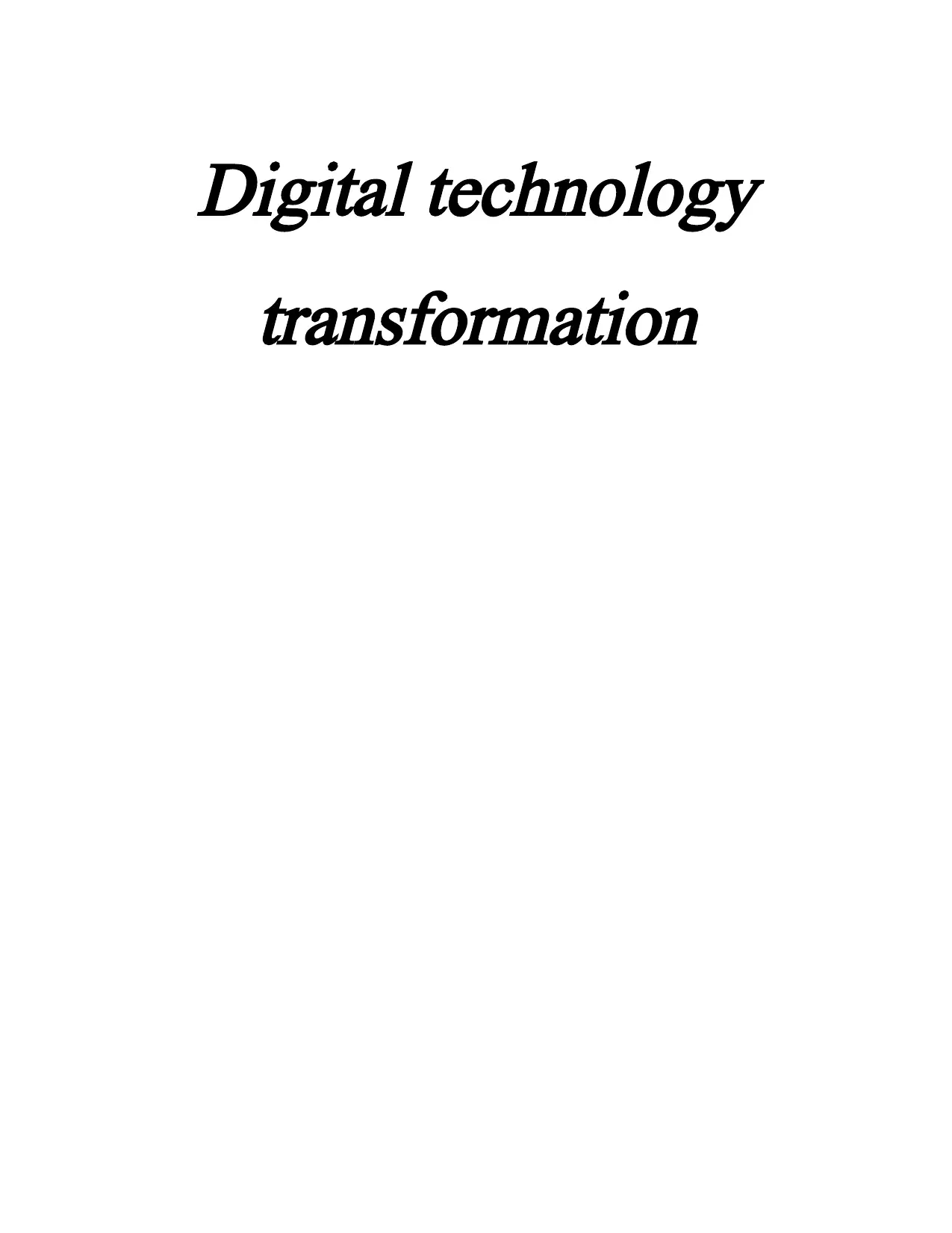
Digital technology
transformation
transformation
Secure Best Marks with AI Grader
Need help grading? Try our AI Grader for instant feedback on your assignments.
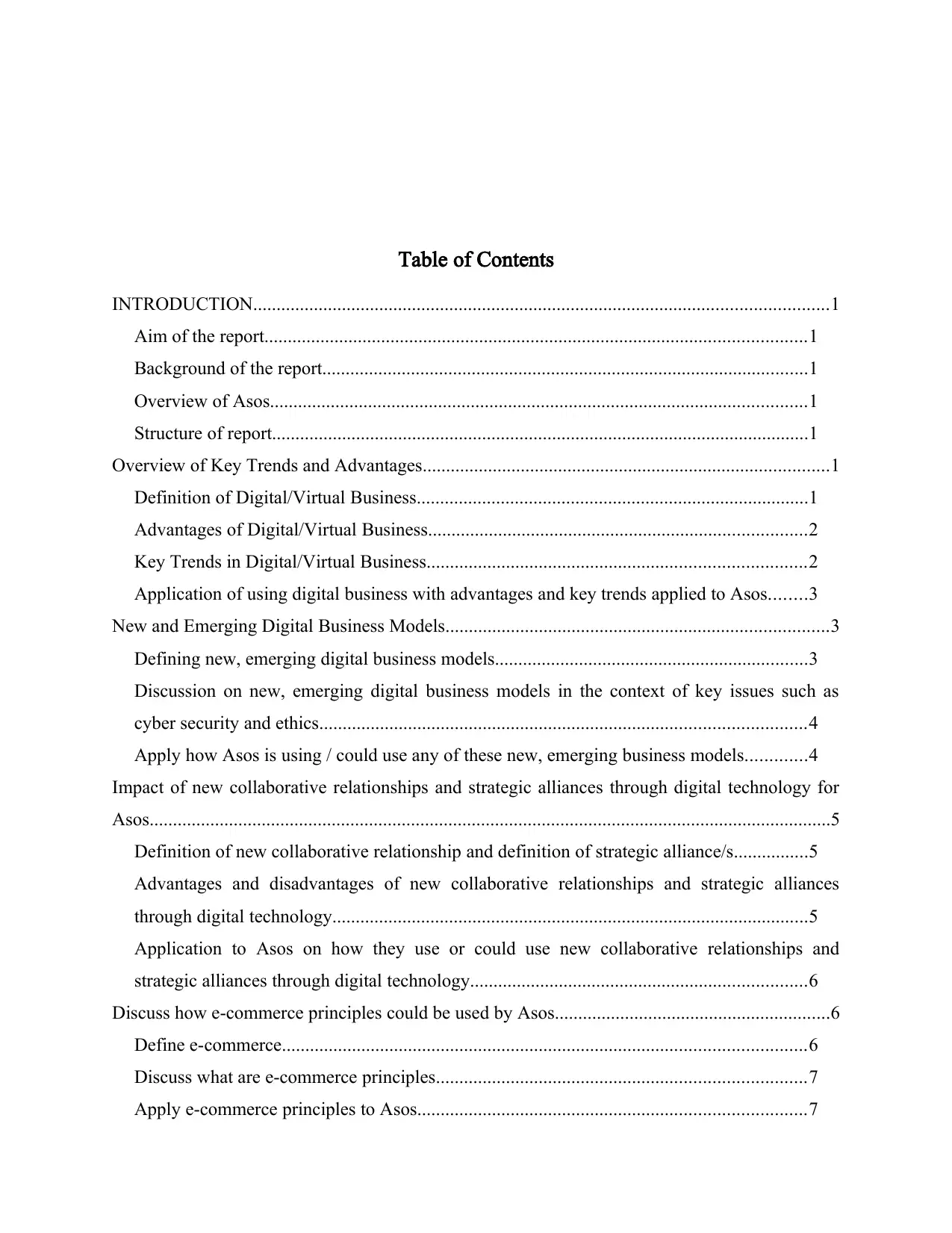
Table of Contents
INTRODUCTION...........................................................................................................................1
Aim of the report....................................................................................................................1
Background of the report........................................................................................................1
Overview of Asos...................................................................................................................1
Structure of report...................................................................................................................1
Overview of Key Trends and Advantages.......................................................................................1
Definition of Digital/Virtual Business....................................................................................1
Advantages of Digital/Virtual Business.................................................................................2
Key Trends in Digital/Virtual Business.................................................................................2
Application of using digital business with advantages and key trends applied to Asos........3
New and Emerging Digital Business Models..................................................................................3
Defining new, emerging digital business models...................................................................3
Discussion on new, emerging digital business models in the context of key issues such as
cyber security and ethics........................................................................................................4
Apply how Asos is using / could use any of these new, emerging business models.............4
Impact of new collaborative relationships and strategic alliances through digital technology for
Asos..................................................................................................................................................5
Definition of new collaborative relationship and definition of strategic alliance/s................5
Advantages and disadvantages of new collaborative relationships and strategic alliances
through digital technology......................................................................................................5
Application to Asos on how they use or could use new collaborative relationships and
strategic alliances through digital technology........................................................................6
Discuss how e-commerce principles could be used by Asos...........................................................6
Define e-commerce................................................................................................................6
Discuss what are e-commerce principles...............................................................................7
Apply e-commerce principles to Asos...................................................................................7
INTRODUCTION...........................................................................................................................1
Aim of the report....................................................................................................................1
Background of the report........................................................................................................1
Overview of Asos...................................................................................................................1
Structure of report...................................................................................................................1
Overview of Key Trends and Advantages.......................................................................................1
Definition of Digital/Virtual Business....................................................................................1
Advantages of Digital/Virtual Business.................................................................................2
Key Trends in Digital/Virtual Business.................................................................................2
Application of using digital business with advantages and key trends applied to Asos........3
New and Emerging Digital Business Models..................................................................................3
Defining new, emerging digital business models...................................................................3
Discussion on new, emerging digital business models in the context of key issues such as
cyber security and ethics........................................................................................................4
Apply how Asos is using / could use any of these new, emerging business models.............4
Impact of new collaborative relationships and strategic alliances through digital technology for
Asos..................................................................................................................................................5
Definition of new collaborative relationship and definition of strategic alliance/s................5
Advantages and disadvantages of new collaborative relationships and strategic alliances
through digital technology......................................................................................................5
Application to Asos on how they use or could use new collaborative relationships and
strategic alliances through digital technology........................................................................6
Discuss how e-commerce principles could be used by Asos...........................................................6
Define e-commerce................................................................................................................6
Discuss what are e-commerce principles...............................................................................7
Apply e-commerce principles to Asos...................................................................................7

CONCLUSION................................................................................................................................8
References:.......................................................................................................................................9
References:.......................................................................................................................................9
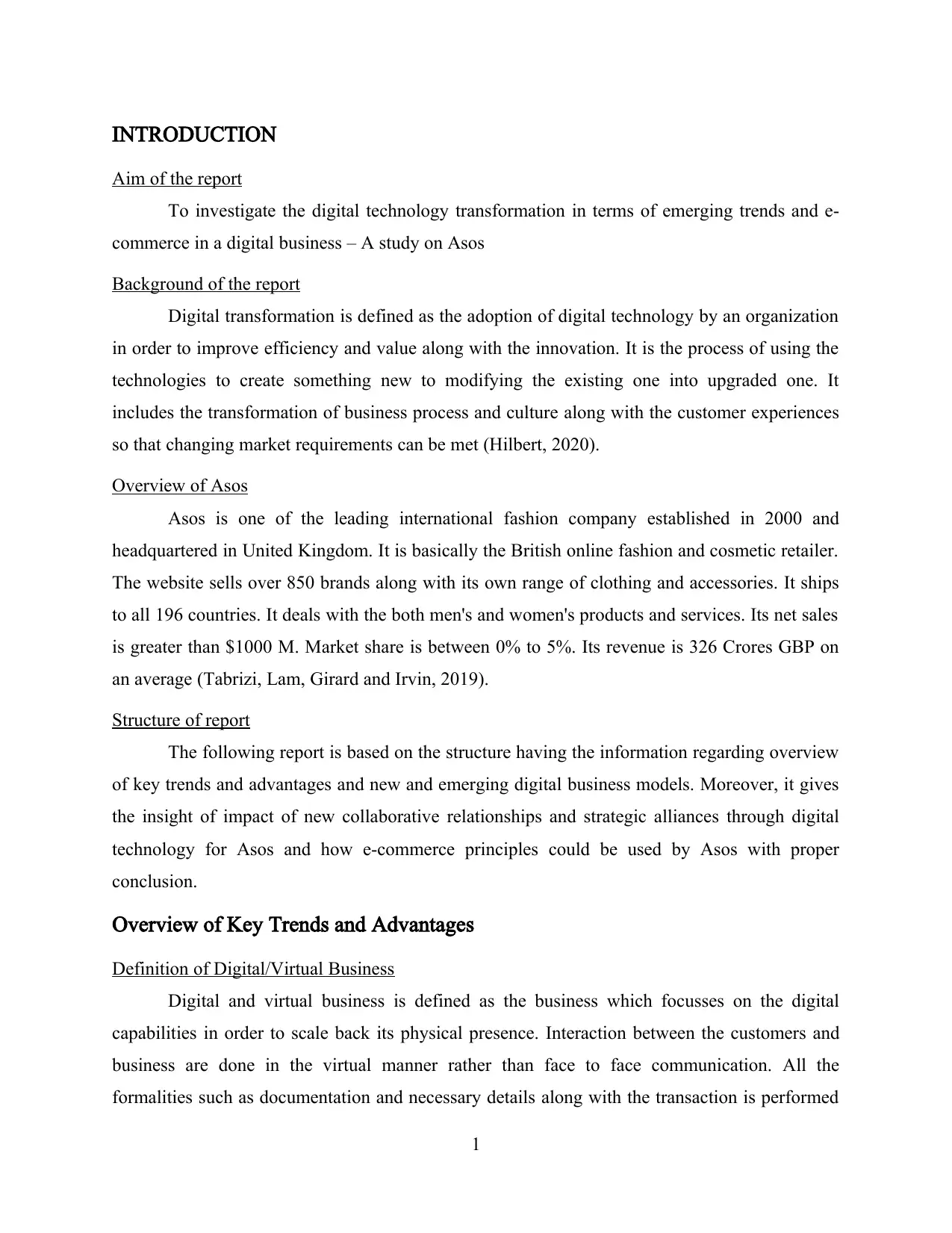
INTRODUCTION
Aim of the report
To investigate the digital technology transformation in terms of emerging trends and e-
commerce in a digital business – A study on Asos
Background of the report
Digital transformation is defined as the adoption of digital technology by an organization
in order to improve efficiency and value along with the innovation. It is the process of using the
technologies to create something new to modifying the existing one into upgraded one. It
includes the transformation of business process and culture along with the customer experiences
so that changing market requirements can be met (Hilbert, 2020).
Overview of Asos
Asos is one of the leading international fashion company established in 2000 and
headquartered in United Kingdom. It is basically the British online fashion and cosmetic retailer.
The website sells over 850 brands along with its own range of clothing and accessories. It ships
to all 196 countries. It deals with the both men's and women's products and services. Its net sales
is greater than $1000 M. Market share is between 0% to 5%. Its revenue is 326 Crores GBP on
an average (Tabrizi, Lam, Girard and Irvin, 2019).
Structure of report
The following report is based on the structure having the information regarding overview
of key trends and advantages and new and emerging digital business models. Moreover, it gives
the insight of impact of new collaborative relationships and strategic alliances through digital
technology for Asos and how e-commerce principles could be used by Asos with proper
conclusion.
Overview of Key Trends and Advantages
Definition of Digital/Virtual Business
Digital and virtual business is defined as the business which focusses on the digital
capabilities in order to scale back its physical presence. Interaction between the customers and
business are done in the virtual manner rather than face to face communication. All the
formalities such as documentation and necessary details along with the transaction is performed
1
Aim of the report
To investigate the digital technology transformation in terms of emerging trends and e-
commerce in a digital business – A study on Asos
Background of the report
Digital transformation is defined as the adoption of digital technology by an organization
in order to improve efficiency and value along with the innovation. It is the process of using the
technologies to create something new to modifying the existing one into upgraded one. It
includes the transformation of business process and culture along with the customer experiences
so that changing market requirements can be met (Hilbert, 2020).
Overview of Asos
Asos is one of the leading international fashion company established in 2000 and
headquartered in United Kingdom. It is basically the British online fashion and cosmetic retailer.
The website sells over 850 brands along with its own range of clothing and accessories. It ships
to all 196 countries. It deals with the both men's and women's products and services. Its net sales
is greater than $1000 M. Market share is between 0% to 5%. Its revenue is 326 Crores GBP on
an average (Tabrizi, Lam, Girard and Irvin, 2019).
Structure of report
The following report is based on the structure having the information regarding overview
of key trends and advantages and new and emerging digital business models. Moreover, it gives
the insight of impact of new collaborative relationships and strategic alliances through digital
technology for Asos and how e-commerce principles could be used by Asos with proper
conclusion.
Overview of Key Trends and Advantages
Definition of Digital/Virtual Business
Digital and virtual business is defined as the business which focusses on the digital
capabilities in order to scale back its physical presence. Interaction between the customers and
business are done in the virtual manner rather than face to face communication. All the
formalities such as documentation and necessary details along with the transaction is performed
1
Secure Best Marks with AI Grader
Need help grading? Try our AI Grader for instant feedback on your assignments.
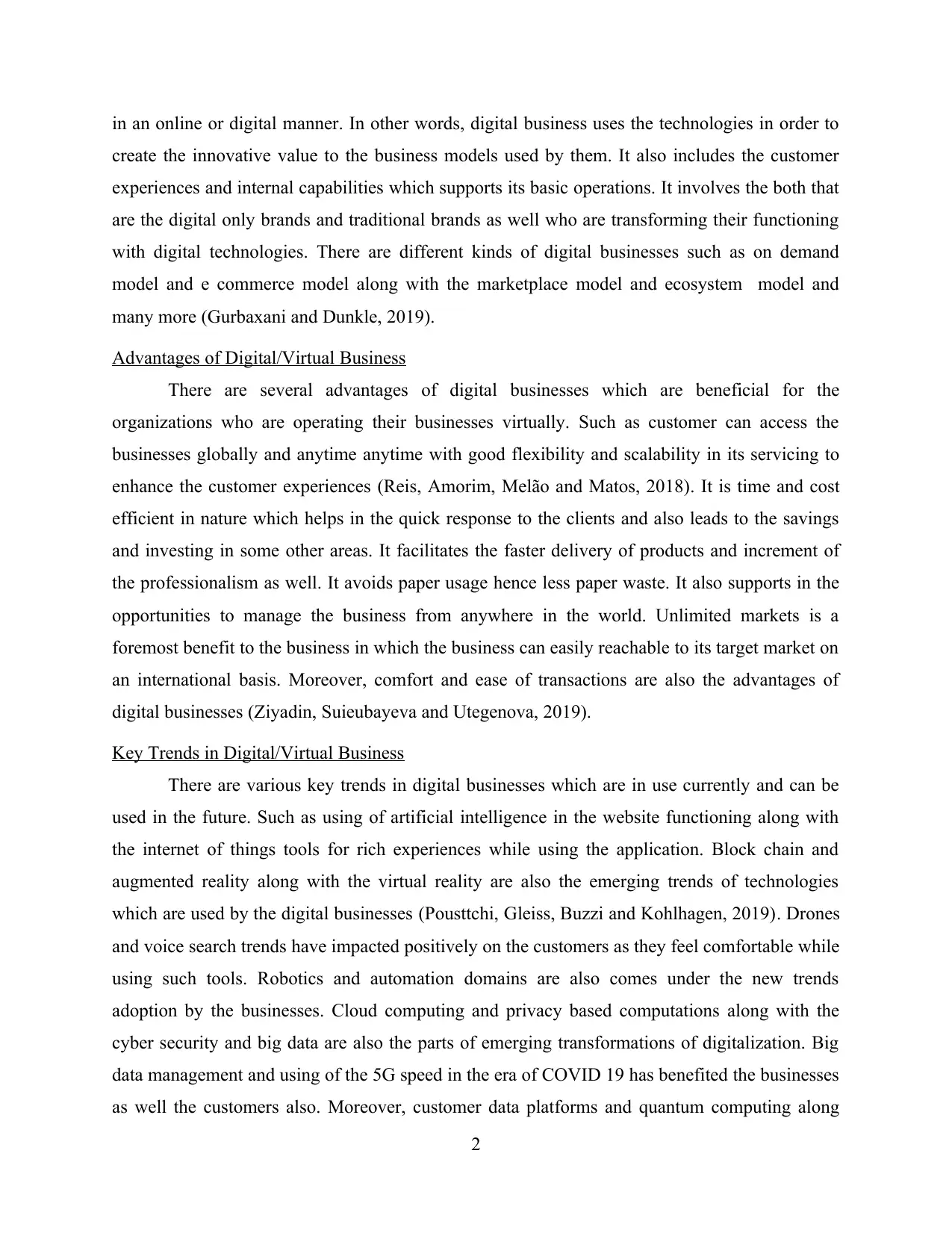
in an online or digital manner. In other words, digital business uses the technologies in order to
create the innovative value to the business models used by them. It also includes the customer
experiences and internal capabilities which supports its basic operations. It involves the both that
are the digital only brands and traditional brands as well who are transforming their functioning
with digital technologies. There are different kinds of digital businesses such as on demand
model and e commerce model along with the marketplace model and ecosystem model and
many more (Gurbaxani and Dunkle, 2019).
Advantages of Digital/Virtual Business
There are several advantages of digital businesses which are beneficial for the
organizations who are operating their businesses virtually. Such as customer can access the
businesses globally and anytime anytime with good flexibility and scalability in its servicing to
enhance the customer experiences (Reis, Amorim, Melão and Matos, 2018). It is time and cost
efficient in nature which helps in the quick response to the clients and also leads to the savings
and investing in some other areas. It facilitates the faster delivery of products and increment of
the professionalism as well. It avoids paper usage hence less paper waste. It also supports in the
opportunities to manage the business from anywhere in the world. Unlimited markets is a
foremost benefit to the business in which the business can easily reachable to its target market on
an international basis. Moreover, comfort and ease of transactions are also the advantages of
digital businesses (Ziyadin, Suieubayeva and Utegenova, 2019).
Key Trends in Digital/Virtual Business
There are various key trends in digital businesses which are in use currently and can be
used in the future. Such as using of artificial intelligence in the website functioning along with
the internet of things tools for rich experiences while using the application. Block chain and
augmented reality along with the virtual reality are also the emerging trends of technologies
which are used by the digital businesses (Pousttchi, Gleiss, Buzzi and Kohlhagen, 2019). Drones
and voice search trends have impacted positively on the customers as they feel comfortable while
using such tools. Robotics and automation domains are also comes under the new trends
adoption by the businesses. Cloud computing and privacy based computations along with the
cyber security and big data are also the parts of emerging transformations of digitalization. Big
data management and using of the 5G speed in the era of COVID 19 has benefited the businesses
as well the customers also. Moreover, customer data platforms and quantum computing along
2
create the innovative value to the business models used by them. It also includes the customer
experiences and internal capabilities which supports its basic operations. It involves the both that
are the digital only brands and traditional brands as well who are transforming their functioning
with digital technologies. There are different kinds of digital businesses such as on demand
model and e commerce model along with the marketplace model and ecosystem model and
many more (Gurbaxani and Dunkle, 2019).
Advantages of Digital/Virtual Business
There are several advantages of digital businesses which are beneficial for the
organizations who are operating their businesses virtually. Such as customer can access the
businesses globally and anytime anytime with good flexibility and scalability in its servicing to
enhance the customer experiences (Reis, Amorim, Melão and Matos, 2018). It is time and cost
efficient in nature which helps in the quick response to the clients and also leads to the savings
and investing in some other areas. It facilitates the faster delivery of products and increment of
the professionalism as well. It avoids paper usage hence less paper waste. It also supports in the
opportunities to manage the business from anywhere in the world. Unlimited markets is a
foremost benefit to the business in which the business can easily reachable to its target market on
an international basis. Moreover, comfort and ease of transactions are also the advantages of
digital businesses (Ziyadin, Suieubayeva and Utegenova, 2019).
Key Trends in Digital/Virtual Business
There are various key trends in digital businesses which are in use currently and can be
used in the future. Such as using of artificial intelligence in the website functioning along with
the internet of things tools for rich experiences while using the application. Block chain and
augmented reality along with the virtual reality are also the emerging trends of technologies
which are used by the digital businesses (Pousttchi, Gleiss, Buzzi and Kohlhagen, 2019). Drones
and voice search trends have impacted positively on the customers as they feel comfortable while
using such tools. Robotics and automation domains are also comes under the new trends
adoption by the businesses. Cloud computing and privacy based computations along with the
cyber security and big data are also the parts of emerging transformations of digitalization. Big
data management and using of the 5G speed in the era of COVID 19 has benefited the businesses
as well the customers also. Moreover, customer data platforms and quantum computing along
2
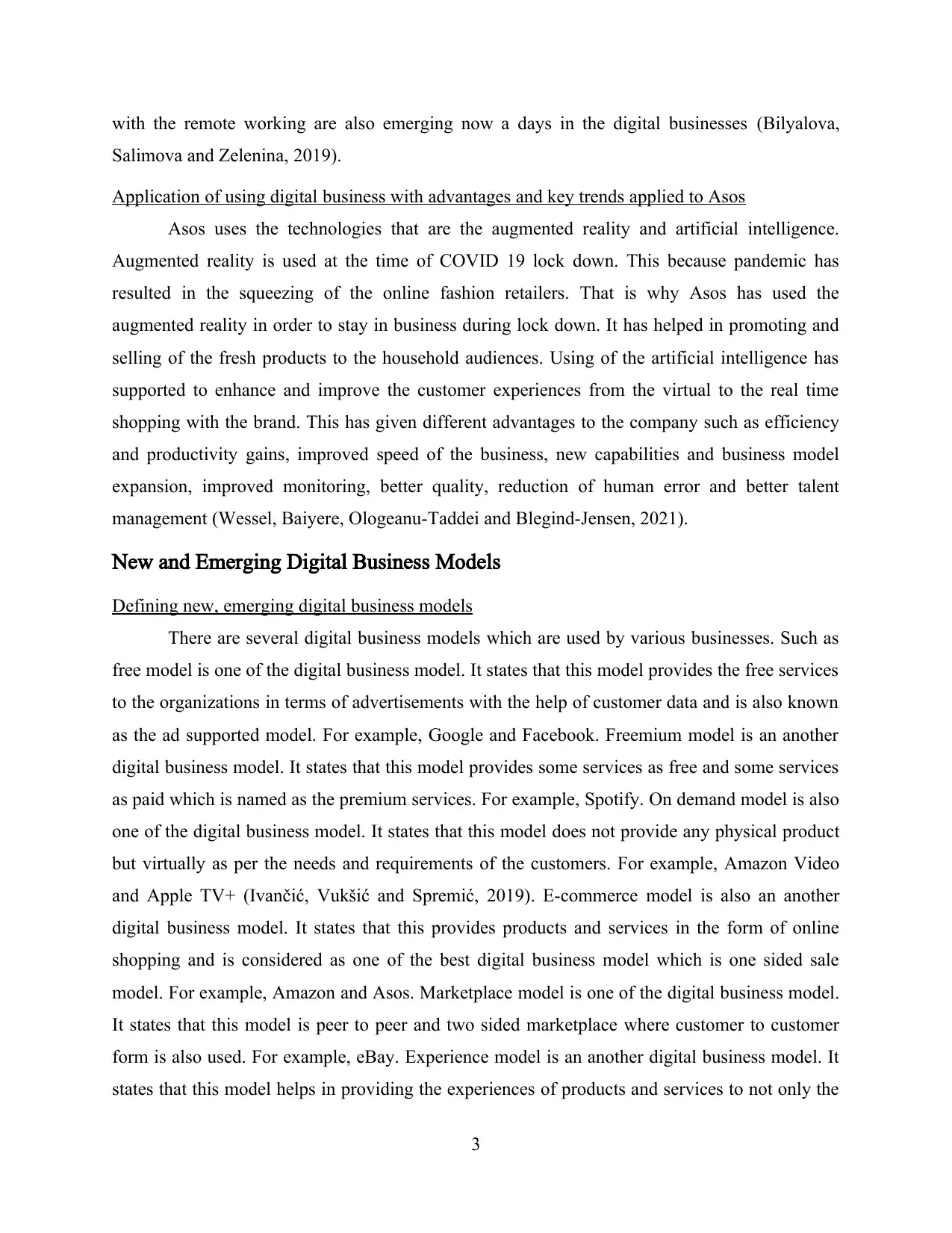
with the remote working are also emerging now a days in the digital businesses (Bilyalova,
Salimova and Zelenina, 2019).
Application of using digital business with advantages and key trends applied to Asos
Asos uses the technologies that are the augmented reality and artificial intelligence.
Augmented reality is used at the time of COVID 19 lock down. This because pandemic has
resulted in the squeezing of the online fashion retailers. That is why Asos has used the
augmented reality in order to stay in business during lock down. It has helped in promoting and
selling of the fresh products to the household audiences. Using of the artificial intelligence has
supported to enhance and improve the customer experiences from the virtual to the real time
shopping with the brand. This has given different advantages to the company such as efficiency
and productivity gains, improved speed of the business, new capabilities and business model
expansion, improved monitoring, better quality, reduction of human error and better talent
management (Wessel, Baiyere, Ologeanu-Taddei and Blegind-Jensen, 2021).
New and Emerging Digital Business Models
Defining new, emerging digital business models
There are several digital business models which are used by various businesses. Such as
free model is one of the digital business model. It states that this model provides the free services
to the organizations in terms of advertisements with the help of customer data and is also known
as the ad supported model. For example, Google and Facebook. Freemium model is an another
digital business model. It states that this model provides some services as free and some services
as paid which is named as the premium services. For example, Spotify. On demand model is also
one of the digital business model. It states that this model does not provide any physical product
but virtually as per the needs and requirements of the customers. For example, Amazon Video
and Apple TV+ (Ivančić, Vukšić and Spremić, 2019). E-commerce model is also an another
digital business model. It states that this provides products and services in the form of online
shopping and is considered as one of the best digital business model which is one sided sale
model. For example, Amazon and Asos. Marketplace model is one of the digital business model.
It states that this model is peer to peer and two sided marketplace where customer to customer
form is also used. For example, eBay. Experience model is an another digital business model. It
states that this model helps in providing the experiences of products and services to not only the
3
Salimova and Zelenina, 2019).
Application of using digital business with advantages and key trends applied to Asos
Asos uses the technologies that are the augmented reality and artificial intelligence.
Augmented reality is used at the time of COVID 19 lock down. This because pandemic has
resulted in the squeezing of the online fashion retailers. That is why Asos has used the
augmented reality in order to stay in business during lock down. It has helped in promoting and
selling of the fresh products to the household audiences. Using of the artificial intelligence has
supported to enhance and improve the customer experiences from the virtual to the real time
shopping with the brand. This has given different advantages to the company such as efficiency
and productivity gains, improved speed of the business, new capabilities and business model
expansion, improved monitoring, better quality, reduction of human error and better talent
management (Wessel, Baiyere, Ologeanu-Taddei and Blegind-Jensen, 2021).
New and Emerging Digital Business Models
Defining new, emerging digital business models
There are several digital business models which are used by various businesses. Such as
free model is one of the digital business model. It states that this model provides the free services
to the organizations in terms of advertisements with the help of customer data and is also known
as the ad supported model. For example, Google and Facebook. Freemium model is an another
digital business model. It states that this model provides some services as free and some services
as paid which is named as the premium services. For example, Spotify. On demand model is also
one of the digital business model. It states that this model does not provide any physical product
but virtually as per the needs and requirements of the customers. For example, Amazon Video
and Apple TV+ (Ivančić, Vukšić and Spremić, 2019). E-commerce model is also an another
digital business model. It states that this provides products and services in the form of online
shopping and is considered as one of the best digital business model which is one sided sale
model. For example, Amazon and Asos. Marketplace model is one of the digital business model.
It states that this model is peer to peer and two sided marketplace where customer to customer
form is also used. For example, eBay. Experience model is an another digital business model. It
states that this model helps in providing the experiences of products and services to not only the
3
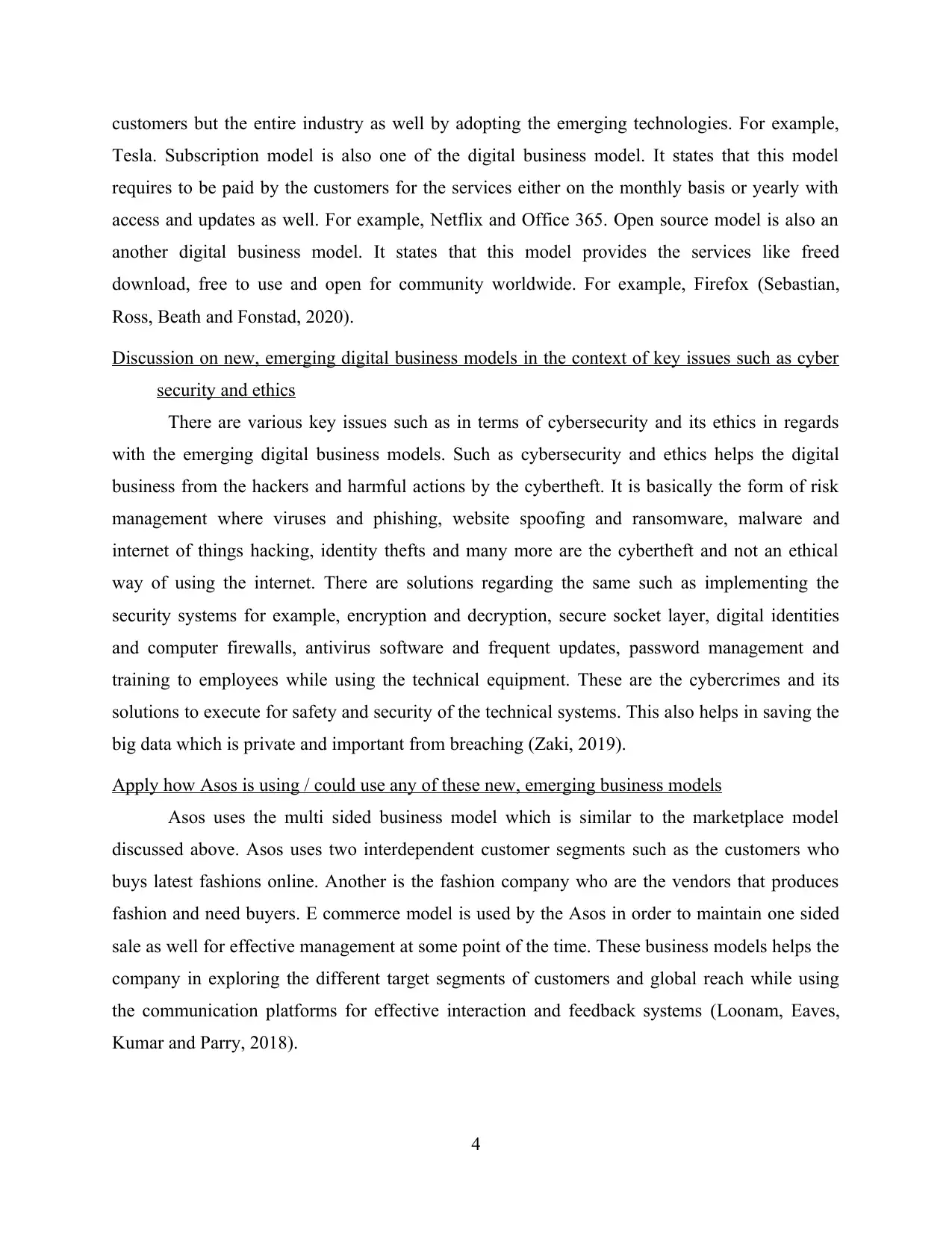
customers but the entire industry as well by adopting the emerging technologies. For example,
Tesla. Subscription model is also one of the digital business model. It states that this model
requires to be paid by the customers for the services either on the monthly basis or yearly with
access and updates as well. For example, Netflix and Office 365. Open source model is also an
another digital business model. It states that this model provides the services like freed
download, free to use and open for community worldwide. For example, Firefox (Sebastian,
Ross, Beath and Fonstad, 2020).
Discussion on new, emerging digital business models in the context of key issues such as cyber
security and ethics
There are various key issues such as in terms of cybersecurity and its ethics in regards
with the emerging digital business models. Such as cybersecurity and ethics helps the digital
business from the hackers and harmful actions by the cybertheft. It is basically the form of risk
management where viruses and phishing, website spoofing and ransomware, malware and
internet of things hacking, identity thefts and many more are the cybertheft and not an ethical
way of using the internet. There are solutions regarding the same such as implementing the
security systems for example, encryption and decryption, secure socket layer, digital identities
and computer firewalls, antivirus software and frequent updates, password management and
training to employees while using the technical equipment. These are the cybercrimes and its
solutions to execute for safety and security of the technical systems. This also helps in saving the
big data which is private and important from breaching (Zaki, 2019).
Apply how Asos is using / could use any of these new, emerging business models
Asos uses the multi sided business model which is similar to the marketplace model
discussed above. Asos uses two interdependent customer segments such as the customers who
buys latest fashions online. Another is the fashion company who are the vendors that produces
fashion and need buyers. E commerce model is used by the Asos in order to maintain one sided
sale as well for effective management at some point of the time. These business models helps the
company in exploring the different target segments of customers and global reach while using
the communication platforms for effective interaction and feedback systems (Loonam, Eaves,
Kumar and Parry, 2018).
4
Tesla. Subscription model is also one of the digital business model. It states that this model
requires to be paid by the customers for the services either on the monthly basis or yearly with
access and updates as well. For example, Netflix and Office 365. Open source model is also an
another digital business model. It states that this model provides the services like freed
download, free to use and open for community worldwide. For example, Firefox (Sebastian,
Ross, Beath and Fonstad, 2020).
Discussion on new, emerging digital business models in the context of key issues such as cyber
security and ethics
There are various key issues such as in terms of cybersecurity and its ethics in regards
with the emerging digital business models. Such as cybersecurity and ethics helps the digital
business from the hackers and harmful actions by the cybertheft. It is basically the form of risk
management where viruses and phishing, website spoofing and ransomware, malware and
internet of things hacking, identity thefts and many more are the cybertheft and not an ethical
way of using the internet. There are solutions regarding the same such as implementing the
security systems for example, encryption and decryption, secure socket layer, digital identities
and computer firewalls, antivirus software and frequent updates, password management and
training to employees while using the technical equipment. These are the cybercrimes and its
solutions to execute for safety and security of the technical systems. This also helps in saving the
big data which is private and important from breaching (Zaki, 2019).
Apply how Asos is using / could use any of these new, emerging business models
Asos uses the multi sided business model which is similar to the marketplace model
discussed above. Asos uses two interdependent customer segments such as the customers who
buys latest fashions online. Another is the fashion company who are the vendors that produces
fashion and need buyers. E commerce model is used by the Asos in order to maintain one sided
sale as well for effective management at some point of the time. These business models helps the
company in exploring the different target segments of customers and global reach while using
the communication platforms for effective interaction and feedback systems (Loonam, Eaves,
Kumar and Parry, 2018).
4
Paraphrase This Document
Need a fresh take? Get an instant paraphrase of this document with our AI Paraphraser
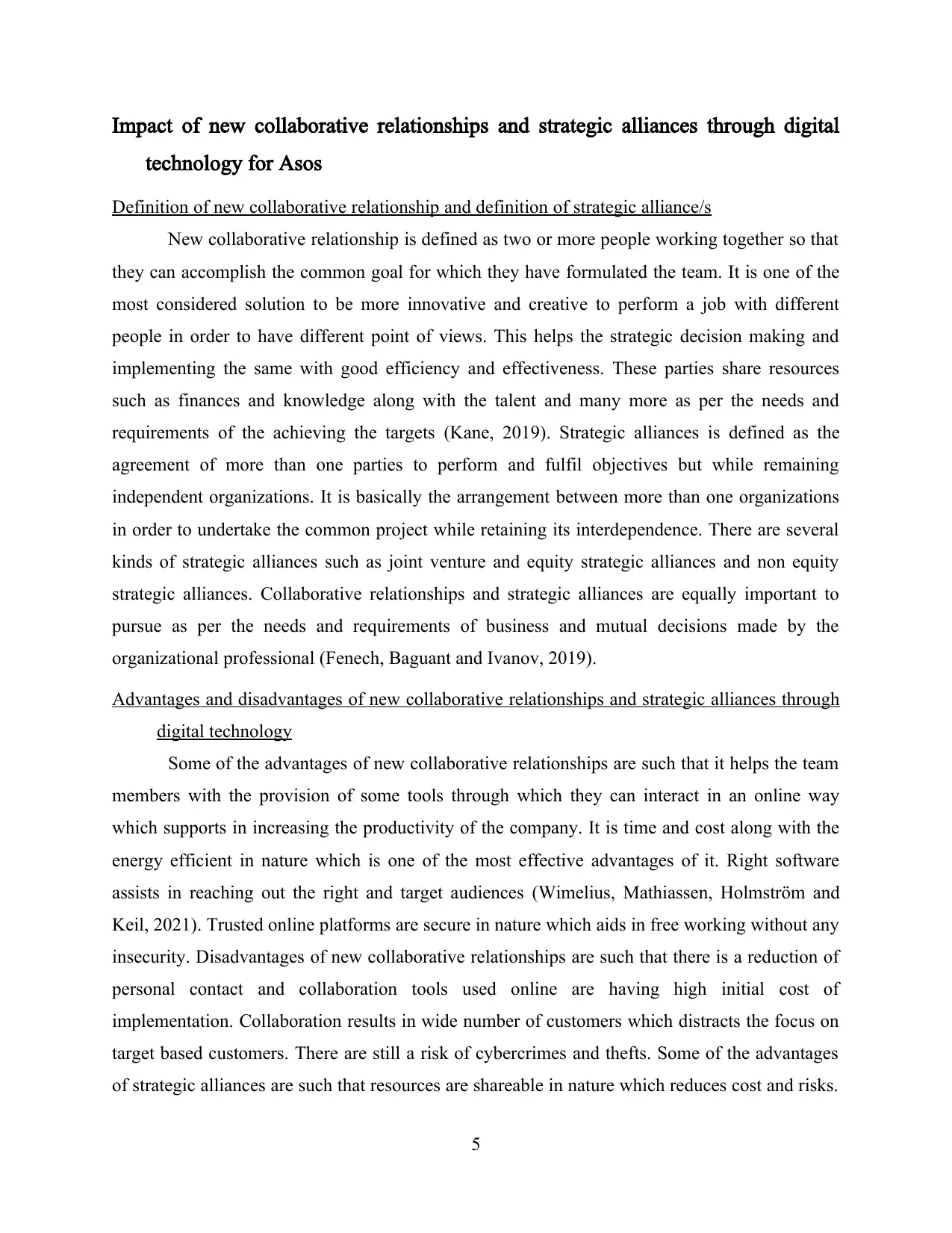
Impact of new collaborative relationships and strategic alliances through digital
technology for Asos
Definition of new collaborative relationship and definition of strategic alliance/s
New collaborative relationship is defined as two or more people working together so that
they can accomplish the common goal for which they have formulated the team. It is one of the
most considered solution to be more innovative and creative to perform a job with different
people in order to have different point of views. This helps the strategic decision making and
implementing the same with good efficiency and effectiveness. These parties share resources
such as finances and knowledge along with the talent and many more as per the needs and
requirements of the achieving the targets (Kane, 2019). Strategic alliances is defined as the
agreement of more than one parties to perform and fulfil objectives but while remaining
independent organizations. It is basically the arrangement between more than one organizations
in order to undertake the common project while retaining its interdependence. There are several
kinds of strategic alliances such as joint venture and equity strategic alliances and non equity
strategic alliances. Collaborative relationships and strategic alliances are equally important to
pursue as per the needs and requirements of business and mutual decisions made by the
organizational professional (Fenech, Baguant and Ivanov, 2019).
Advantages and disadvantages of new collaborative relationships and strategic alliances through
digital technology
Some of the advantages of new collaborative relationships are such that it helps the team
members with the provision of some tools through which they can interact in an online way
which supports in increasing the productivity of the company. It is time and cost along with the
energy efficient in nature which is one of the most effective advantages of it. Right software
assists in reaching out the right and target audiences (Wimelius, Mathiassen, Holmström and
Keil, 2021). Trusted online platforms are secure in nature which aids in free working without any
insecurity. Disadvantages of new collaborative relationships are such that there is a reduction of
personal contact and collaboration tools used online are having high initial cost of
implementation. Collaboration results in wide number of customers which distracts the focus on
target based customers. There are still a risk of cybercrimes and thefts. Some of the advantages
of strategic alliances are such that resources are shareable in nature which reduces cost and risks.
5
technology for Asos
Definition of new collaborative relationship and definition of strategic alliance/s
New collaborative relationship is defined as two or more people working together so that
they can accomplish the common goal for which they have formulated the team. It is one of the
most considered solution to be more innovative and creative to perform a job with different
people in order to have different point of views. This helps the strategic decision making and
implementing the same with good efficiency and effectiveness. These parties share resources
such as finances and knowledge along with the talent and many more as per the needs and
requirements of the achieving the targets (Kane, 2019). Strategic alliances is defined as the
agreement of more than one parties to perform and fulfil objectives but while remaining
independent organizations. It is basically the arrangement between more than one organizations
in order to undertake the common project while retaining its interdependence. There are several
kinds of strategic alliances such as joint venture and equity strategic alliances and non equity
strategic alliances. Collaborative relationships and strategic alliances are equally important to
pursue as per the needs and requirements of business and mutual decisions made by the
organizational professional (Fenech, Baguant and Ivanov, 2019).
Advantages and disadvantages of new collaborative relationships and strategic alliances through
digital technology
Some of the advantages of new collaborative relationships are such that it helps the team
members with the provision of some tools through which they can interact in an online way
which supports in increasing the productivity of the company. It is time and cost along with the
energy efficient in nature which is one of the most effective advantages of it. Right software
assists in reaching out the right and target audiences (Wimelius, Mathiassen, Holmström and
Keil, 2021). Trusted online platforms are secure in nature which aids in free working without any
insecurity. Disadvantages of new collaborative relationships are such that there is a reduction of
personal contact and collaboration tools used online are having high initial cost of
implementation. Collaboration results in wide number of customers which distracts the focus on
target based customers. There are still a risk of cybercrimes and thefts. Some of the advantages
of strategic alliances are such that resources are shareable in nature which reduces cost and risks.
5
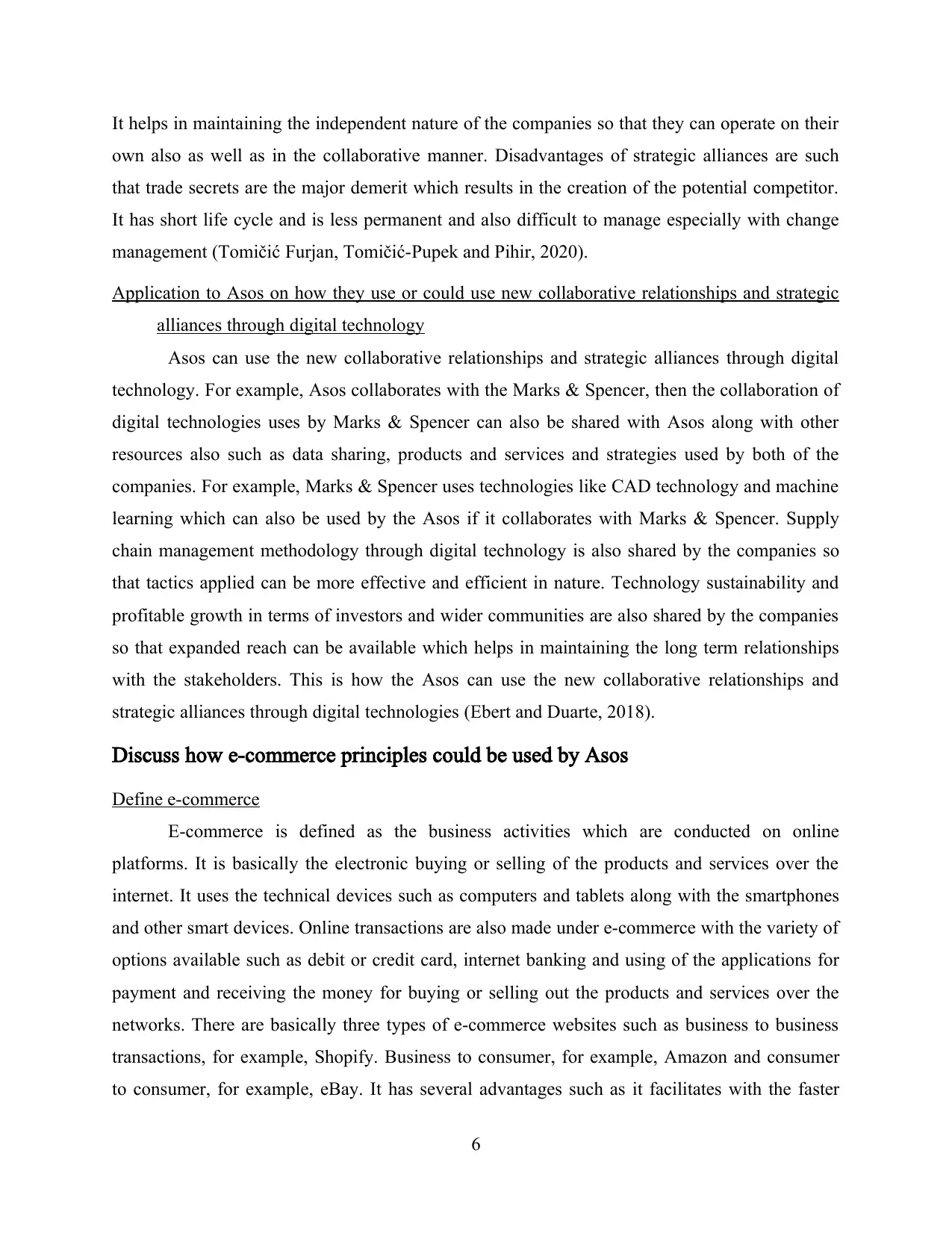
It helps in maintaining the independent nature of the companies so that they can operate on their
own also as well as in the collaborative manner. Disadvantages of strategic alliances are such
that trade secrets are the major demerit which results in the creation of the potential competitor.
It has short life cycle and is less permanent and also difficult to manage especially with change
management (Tomičić Furjan, Tomičić-Pupek and Pihir, 2020).
Application to Asos on how they use or could use new collaborative relationships and strategic
alliances through digital technology
Asos can use the new collaborative relationships and strategic alliances through digital
technology. For example, Asos collaborates with the Marks & Spencer, then the collaboration of
digital technologies uses by Marks & Spencer can also be shared with Asos along with other
resources also such as data sharing, products and services and strategies used by both of the
companies. For example, Marks & Spencer uses technologies like CAD technology and machine
learning which can also be used by the Asos if it collaborates with Marks & Spencer. Supply
chain management methodology through digital technology is also shared by the companies so
that tactics applied can be more effective and efficient in nature. Technology sustainability and
profitable growth in terms of investors and wider communities are also shared by the companies
so that expanded reach can be available which helps in maintaining the long term relationships
with the stakeholders. This is how the Asos can use the new collaborative relationships and
strategic alliances through digital technologies (Ebert and Duarte, 2018).
Discuss how e-commerce principles could be used by Asos
Define e-commerce
E-commerce is defined as the business activities which are conducted on online
platforms. It is basically the electronic buying or selling of the products and services over the
internet. It uses the technical devices such as computers and tablets along with the smartphones
and other smart devices. Online transactions are also made under e-commerce with the variety of
options available such as debit or credit card, internet banking and using of the applications for
payment and receiving the money for buying or selling out the products and services over the
networks. There are basically three types of e-commerce websites such as business to business
transactions, for example, Shopify. Business to consumer, for example, Amazon and consumer
to consumer, for example, eBay. It has several advantages such as it facilitates with the faster
6
own also as well as in the collaborative manner. Disadvantages of strategic alliances are such
that trade secrets are the major demerit which results in the creation of the potential competitor.
It has short life cycle and is less permanent and also difficult to manage especially with change
management (Tomičić Furjan, Tomičić-Pupek and Pihir, 2020).
Application to Asos on how they use or could use new collaborative relationships and strategic
alliances through digital technology
Asos can use the new collaborative relationships and strategic alliances through digital
technology. For example, Asos collaborates with the Marks & Spencer, then the collaboration of
digital technologies uses by Marks & Spencer can also be shared with Asos along with other
resources also such as data sharing, products and services and strategies used by both of the
companies. For example, Marks & Spencer uses technologies like CAD technology and machine
learning which can also be used by the Asos if it collaborates with Marks & Spencer. Supply
chain management methodology through digital technology is also shared by the companies so
that tactics applied can be more effective and efficient in nature. Technology sustainability and
profitable growth in terms of investors and wider communities are also shared by the companies
so that expanded reach can be available which helps in maintaining the long term relationships
with the stakeholders. This is how the Asos can use the new collaborative relationships and
strategic alliances through digital technologies (Ebert and Duarte, 2018).
Discuss how e-commerce principles could be used by Asos
Define e-commerce
E-commerce is defined as the business activities which are conducted on online
platforms. It is basically the electronic buying or selling of the products and services over the
internet. It uses the technical devices such as computers and tablets along with the smartphones
and other smart devices. Online transactions are also made under e-commerce with the variety of
options available such as debit or credit card, internet banking and using of the applications for
payment and receiving the money for buying or selling out the products and services over the
networks. There are basically three types of e-commerce websites such as business to business
transactions, for example, Shopify. Business to consumer, for example, Amazon and consumer
to consumer, for example, eBay. It has several advantages such as it facilitates with the faster
6
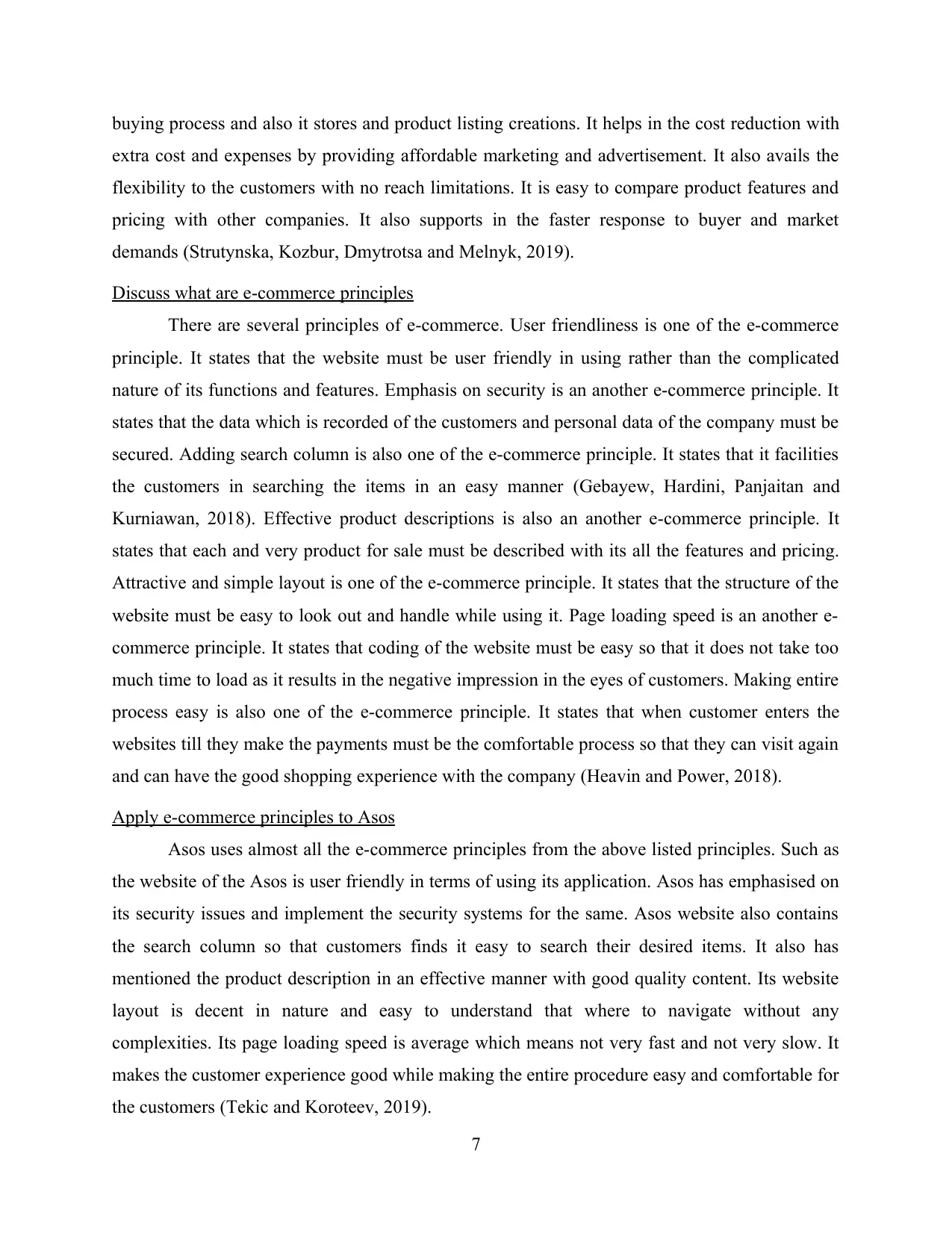
buying process and also it stores and product listing creations. It helps in the cost reduction with
extra cost and expenses by providing affordable marketing and advertisement. It also avails the
flexibility to the customers with no reach limitations. It is easy to compare product features and
pricing with other companies. It also supports in the faster response to buyer and market
demands (Strutynska, Kozbur, Dmytrotsa and Melnyk, 2019).
Discuss what are e-commerce principles
There are several principles of e-commerce. User friendliness is one of the e-commerce
principle. It states that the website must be user friendly in using rather than the complicated
nature of its functions and features. Emphasis on security is an another e-commerce principle. It
states that the data which is recorded of the customers and personal data of the company must be
secured. Adding search column is also one of the e-commerce principle. It states that it facilities
the customers in searching the items in an easy manner (Gebayew, Hardini, Panjaitan and
Kurniawan, 2018). Effective product descriptions is also an another e-commerce principle. It
states that each and very product for sale must be described with its all the features and pricing.
Attractive and simple layout is one of the e-commerce principle. It states that the structure of the
website must be easy to look out and handle while using it. Page loading speed is an another e-
commerce principle. It states that coding of the website must be easy so that it does not take too
much time to load as it results in the negative impression in the eyes of customers. Making entire
process easy is also one of the e-commerce principle. It states that when customer enters the
websites till they make the payments must be the comfortable process so that they can visit again
and can have the good shopping experience with the company (Heavin and Power, 2018).
Apply e-commerce principles to Asos
Asos uses almost all the e-commerce principles from the above listed principles. Such as
the website of the Asos is user friendly in terms of using its application. Asos has emphasised on
its security issues and implement the security systems for the same. Asos website also contains
the search column so that customers finds it easy to search their desired items. It also has
mentioned the product description in an effective manner with good quality content. Its website
layout is decent in nature and easy to understand that where to navigate without any
complexities. Its page loading speed is average which means not very fast and not very slow. It
makes the customer experience good while making the entire procedure easy and comfortable for
the customers (Tekic and Koroteev, 2019).
7
extra cost and expenses by providing affordable marketing and advertisement. It also avails the
flexibility to the customers with no reach limitations. It is easy to compare product features and
pricing with other companies. It also supports in the faster response to buyer and market
demands (Strutynska, Kozbur, Dmytrotsa and Melnyk, 2019).
Discuss what are e-commerce principles
There are several principles of e-commerce. User friendliness is one of the e-commerce
principle. It states that the website must be user friendly in using rather than the complicated
nature of its functions and features. Emphasis on security is an another e-commerce principle. It
states that the data which is recorded of the customers and personal data of the company must be
secured. Adding search column is also one of the e-commerce principle. It states that it facilities
the customers in searching the items in an easy manner (Gebayew, Hardini, Panjaitan and
Kurniawan, 2018). Effective product descriptions is also an another e-commerce principle. It
states that each and very product for sale must be described with its all the features and pricing.
Attractive and simple layout is one of the e-commerce principle. It states that the structure of the
website must be easy to look out and handle while using it. Page loading speed is an another e-
commerce principle. It states that coding of the website must be easy so that it does not take too
much time to load as it results in the negative impression in the eyes of customers. Making entire
process easy is also one of the e-commerce principle. It states that when customer enters the
websites till they make the payments must be the comfortable process so that they can visit again
and can have the good shopping experience with the company (Heavin and Power, 2018).
Apply e-commerce principles to Asos
Asos uses almost all the e-commerce principles from the above listed principles. Such as
the website of the Asos is user friendly in terms of using its application. Asos has emphasised on
its security issues and implement the security systems for the same. Asos website also contains
the search column so that customers finds it easy to search their desired items. It also has
mentioned the product description in an effective manner with good quality content. Its website
layout is decent in nature and easy to understand that where to navigate without any
complexities. Its page loading speed is average which means not very fast and not very slow. It
makes the customer experience good while making the entire procedure easy and comfortable for
the customers (Tekic and Koroteev, 2019).
7
Secure Best Marks with AI Grader
Need help grading? Try our AI Grader for instant feedback on your assignments.
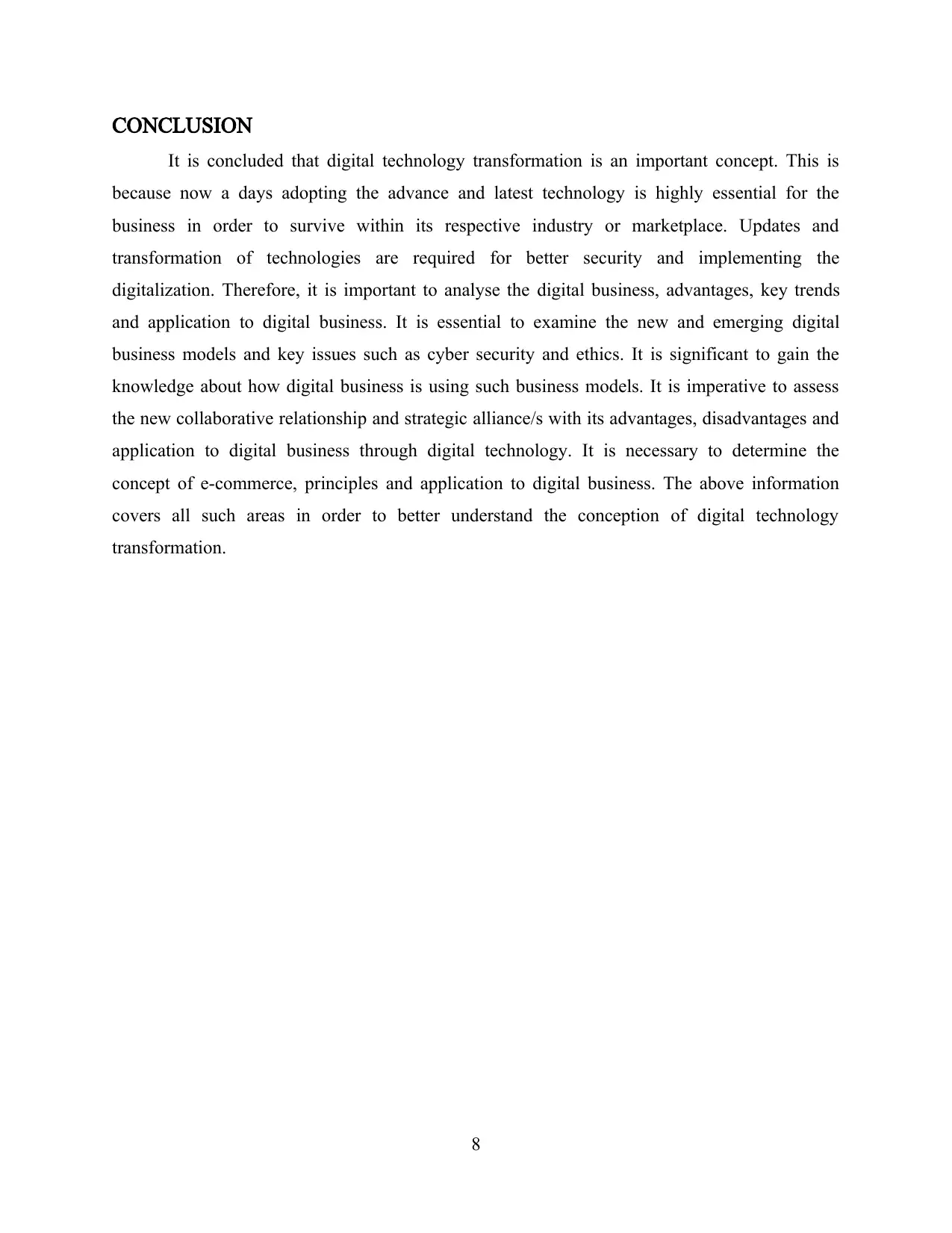
CONCLUSION
It is concluded that digital technology transformation is an important concept. This is
because now a days adopting the advance and latest technology is highly essential for the
business in order to survive within its respective industry or marketplace. Updates and
transformation of technologies are required for better security and implementing the
digitalization. Therefore, it is important to analyse the digital business, advantages, key trends
and application to digital business. It is essential to examine the new and emerging digital
business models and key issues such as cyber security and ethics. It is significant to gain the
knowledge about how digital business is using such business models. It is imperative to assess
the new collaborative relationship and strategic alliance/s with its advantages, disadvantages and
application to digital business through digital technology. It is necessary to determine the
concept of e-commerce, principles and application to digital business. The above information
covers all such areas in order to better understand the conception of digital technology
transformation.
8
It is concluded that digital technology transformation is an important concept. This is
because now a days adopting the advance and latest technology is highly essential for the
business in order to survive within its respective industry or marketplace. Updates and
transformation of technologies are required for better security and implementing the
digitalization. Therefore, it is important to analyse the digital business, advantages, key trends
and application to digital business. It is essential to examine the new and emerging digital
business models and key issues such as cyber security and ethics. It is significant to gain the
knowledge about how digital business is using such business models. It is imperative to assess
the new collaborative relationship and strategic alliance/s with its advantages, disadvantages and
application to digital business through digital technology. It is necessary to determine the
concept of e-commerce, principles and application to digital business. The above information
covers all such areas in order to better understand the conception of digital technology
transformation.
8
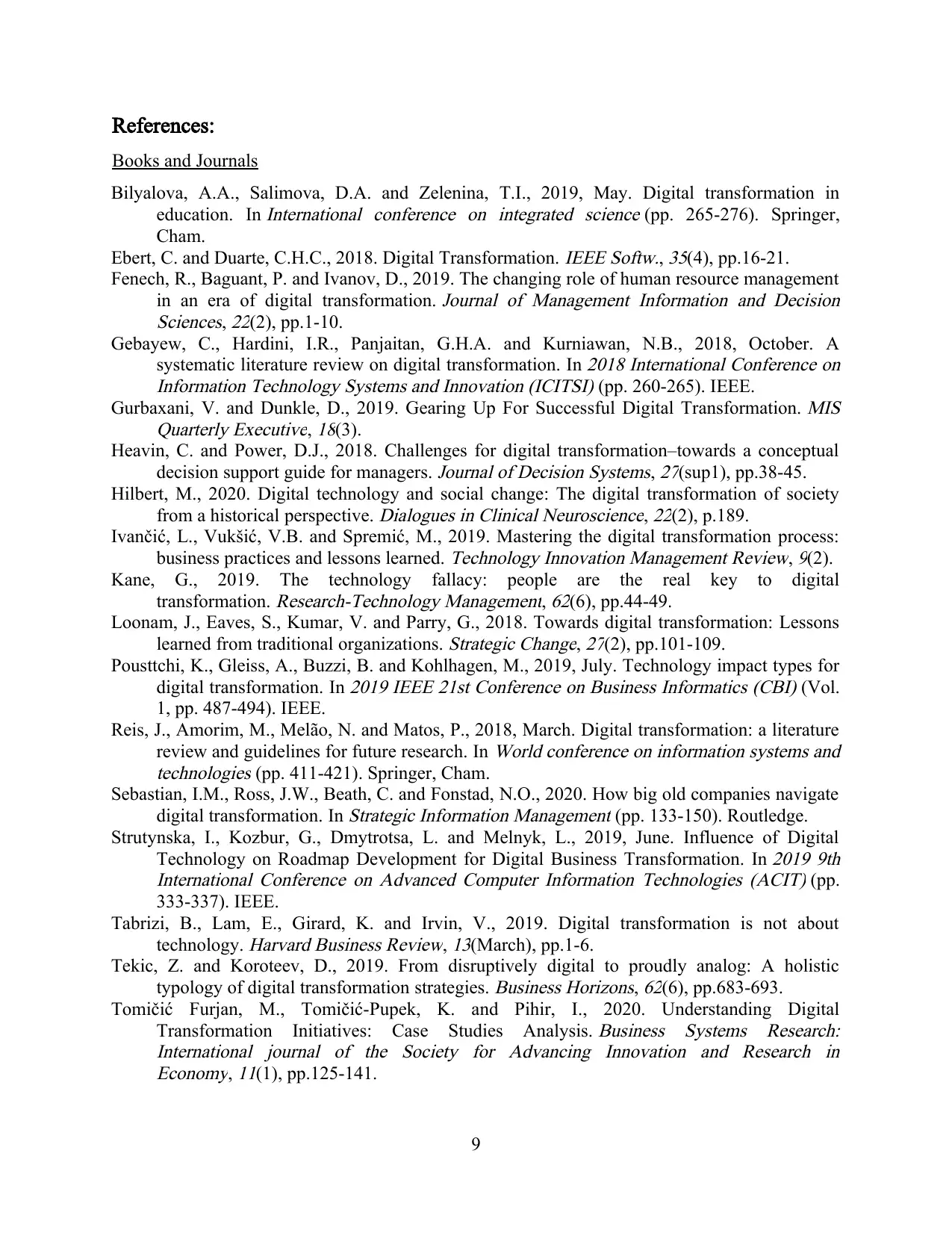
References:
Books and Journals
Bilyalova, A.A., Salimova, D.A. and Zelenina, T.I., 2019, May. Digital transformation in
education. In
International conference on integrated science (pp. 265-276). Springer,
Cham.
Ebert, C. and Duarte, C.H.C., 2018. Digital Transformation.
IEEE Softw.,
35(4), pp.16-21.
Fenech, R., Baguant, P. and Ivanov, D., 2019. The changing role of human resource management
in an era of digital transformation.
Journal of Management Information and Decision
Sciences,
22(2), pp.1-10.
Gebayew, C., Hardini, I.R., Panjaitan, G.H.A. and Kurniawan, N.B., 2018, October. A
systematic literature review on digital transformation. In
2018 International Conference on
Information Technology Systems and Innovation (ICITSI) (pp. 260-265). IEEE.
Gurbaxani, V. and Dunkle, D., 2019. Gearing Up For Successful Digital Transformation.
MIS
Quarterly Executive,
18(3).
Heavin, C. and Power, D.J., 2018. Challenges for digital transformation–towards a conceptual
decision support guide for managers.
Journal of Decision Systems,
27(sup1), pp.38-45.
Hilbert, M., 2020. Digital technology and social change: The digital transformation of society
from a historical perspective.
Dialogues in Clinical Neuroscience,
22(2), p.189.
Ivančić, L., Vukšić, V.B. and Spremić, M., 2019. Mastering the digital transformation process:
business practices and lessons learned.
Technology Innovation Management Review,
9(2).
Kane, G., 2019. The technology fallacy: people are the real key to digital
transformation.
Research-Technology Management,
62(6), pp.44-49.
Loonam, J., Eaves, S., Kumar, V. and Parry, G., 2018. Towards digital transformation: Lessons
learned from traditional organizations.
Strategic Change,
27(2), pp.101-109.
Pousttchi, K., Gleiss, A., Buzzi, B. and Kohlhagen, M., 2019, July. Technology impact types for
digital transformation. In
2019 IEEE 21st Conference on Business Informatics (CBI) (Vol.
1, pp. 487-494). IEEE.
Reis, J., Amorim, M., Melão, N. and Matos, P., 2018, March. Digital transformation: a literature
review and guidelines for future research. In
World conference on information systems and
technologies (pp. 411-421). Springer, Cham.
Sebastian, I.M., Ross, J.W., Beath, C. and Fonstad, N.O., 2020. How big old companies navigate
digital transformation. In
Strategic Information Management (pp. 133-150). Routledge.
Strutynska, I., Kozbur, G., Dmytrotsa, L. and Melnyk, L., 2019, June. Influence of Digital
Technology on Roadmap Development for Digital Business Transformation. In
2019 9th
International Conference on Advanced Computer Information Technologies (ACIT) (pp.
333-337). IEEE.
Tabrizi, B., Lam, E., Girard, K. and Irvin, V., 2019. Digital transformation is not about
technology.
Harvard Business Review,
13(March), pp.1-6.
Tekic, Z. and Koroteev, D., 2019. From disruptively digital to proudly analog: A holistic
typology of digital transformation strategies.
Business Horizons,
62(6), pp.683-693.
Tomičić Furjan, M., Tomičić-Pupek, K. and Pihir, I., 2020. Understanding Digital
Transformation Initiatives: Case Studies Analysis.
Business Systems Research:
International journal of the Society for Advancing Innovation and Research in
Economy,
11(1), pp.125-141.
9
Books and Journals
Bilyalova, A.A., Salimova, D.A. and Zelenina, T.I., 2019, May. Digital transformation in
education. In
International conference on integrated science (pp. 265-276). Springer,
Cham.
Ebert, C. and Duarte, C.H.C., 2018. Digital Transformation.
IEEE Softw.,
35(4), pp.16-21.
Fenech, R., Baguant, P. and Ivanov, D., 2019. The changing role of human resource management
in an era of digital transformation.
Journal of Management Information and Decision
Sciences,
22(2), pp.1-10.
Gebayew, C., Hardini, I.R., Panjaitan, G.H.A. and Kurniawan, N.B., 2018, October. A
systematic literature review on digital transformation. In
2018 International Conference on
Information Technology Systems and Innovation (ICITSI) (pp. 260-265). IEEE.
Gurbaxani, V. and Dunkle, D., 2019. Gearing Up For Successful Digital Transformation.
MIS
Quarterly Executive,
18(3).
Heavin, C. and Power, D.J., 2018. Challenges for digital transformation–towards a conceptual
decision support guide for managers.
Journal of Decision Systems,
27(sup1), pp.38-45.
Hilbert, M., 2020. Digital technology and social change: The digital transformation of society
from a historical perspective.
Dialogues in Clinical Neuroscience,
22(2), p.189.
Ivančić, L., Vukšić, V.B. and Spremić, M., 2019. Mastering the digital transformation process:
business practices and lessons learned.
Technology Innovation Management Review,
9(2).
Kane, G., 2019. The technology fallacy: people are the real key to digital
transformation.
Research-Technology Management,
62(6), pp.44-49.
Loonam, J., Eaves, S., Kumar, V. and Parry, G., 2018. Towards digital transformation: Lessons
learned from traditional organizations.
Strategic Change,
27(2), pp.101-109.
Pousttchi, K., Gleiss, A., Buzzi, B. and Kohlhagen, M., 2019, July. Technology impact types for
digital transformation. In
2019 IEEE 21st Conference on Business Informatics (CBI) (Vol.
1, pp. 487-494). IEEE.
Reis, J., Amorim, M., Melão, N. and Matos, P., 2018, March. Digital transformation: a literature
review and guidelines for future research. In
World conference on information systems and
technologies (pp. 411-421). Springer, Cham.
Sebastian, I.M., Ross, J.W., Beath, C. and Fonstad, N.O., 2020. How big old companies navigate
digital transformation. In
Strategic Information Management (pp. 133-150). Routledge.
Strutynska, I., Kozbur, G., Dmytrotsa, L. and Melnyk, L., 2019, June. Influence of Digital
Technology on Roadmap Development for Digital Business Transformation. In
2019 9th
International Conference on Advanced Computer Information Technologies (ACIT) (pp.
333-337). IEEE.
Tabrizi, B., Lam, E., Girard, K. and Irvin, V., 2019. Digital transformation is not about
technology.
Harvard Business Review,
13(March), pp.1-6.
Tekic, Z. and Koroteev, D., 2019. From disruptively digital to proudly analog: A holistic
typology of digital transformation strategies.
Business Horizons,
62(6), pp.683-693.
Tomičić Furjan, M., Tomičić-Pupek, K. and Pihir, I., 2020. Understanding Digital
Transformation Initiatives: Case Studies Analysis.
Business Systems Research:
International journal of the Society for Advancing Innovation and Research in
Economy,
11(1), pp.125-141.
9
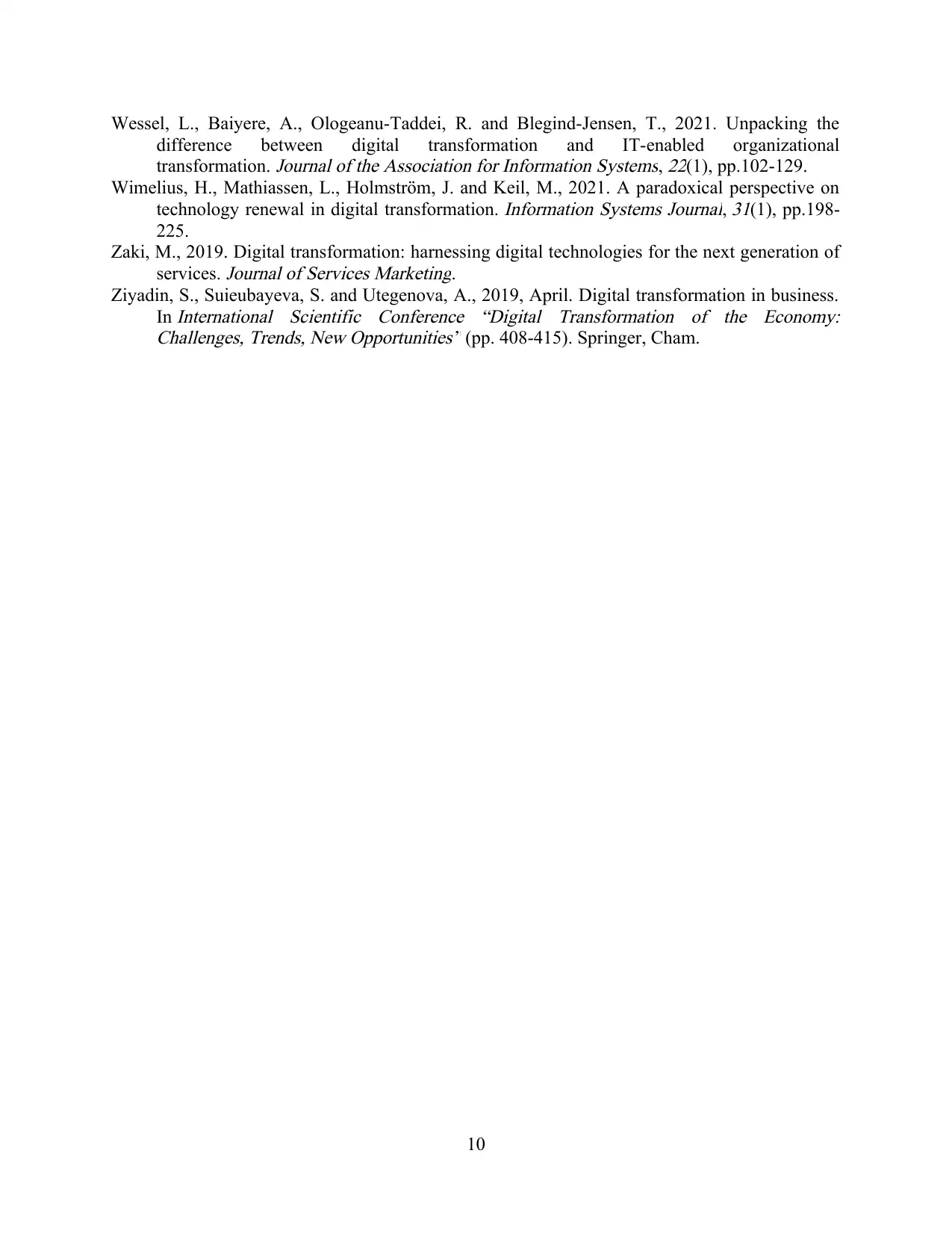
Wessel, L., Baiyere, A., Ologeanu-Taddei, R. and Blegind-Jensen, T., 2021. Unpacking the
difference between digital transformation and IT-enabled organizational
transformation.
Journal of the Association for Information Systems,
22(1), pp.102-129.
Wimelius, H., Mathiassen, L., Holmström, J. and Keil, M., 2021. A paradoxical perspective on
technology renewal in digital transformation.
Information Systems Journal,
31(1), pp.198-
225.
Zaki, M., 2019. Digital transformation: harnessing digital technologies for the next generation of
services.
Journal of Services Marketing.
Ziyadin, S., Suieubayeva, S. and Utegenova, A., 2019, April. Digital transformation in business.
In
International Scientific Conference “Digital Transformation of the Economy:
Challenges, Trends, New Opportunities” (pp. 408-415). Springer, Cham.
10
difference between digital transformation and IT-enabled organizational
transformation.
Journal of the Association for Information Systems,
22(1), pp.102-129.
Wimelius, H., Mathiassen, L., Holmström, J. and Keil, M., 2021. A paradoxical perspective on
technology renewal in digital transformation.
Information Systems Journal,
31(1), pp.198-
225.
Zaki, M., 2019. Digital transformation: harnessing digital technologies for the next generation of
services.
Journal of Services Marketing.
Ziyadin, S., Suieubayeva, S. and Utegenova, A., 2019, April. Digital transformation in business.
In
International Scientific Conference “Digital Transformation of the Economy:
Challenges, Trends, New Opportunities” (pp. 408-415). Springer, Cham.
10
1 out of 13
Related Documents
Your All-in-One AI-Powered Toolkit for Academic Success.
+13062052269
info@desklib.com
Available 24*7 on WhatsApp / Email
![[object Object]](/_next/static/media/star-bottom.7253800d.svg)
Unlock your academic potential
© 2024 | Zucol Services PVT LTD | All rights reserved.




